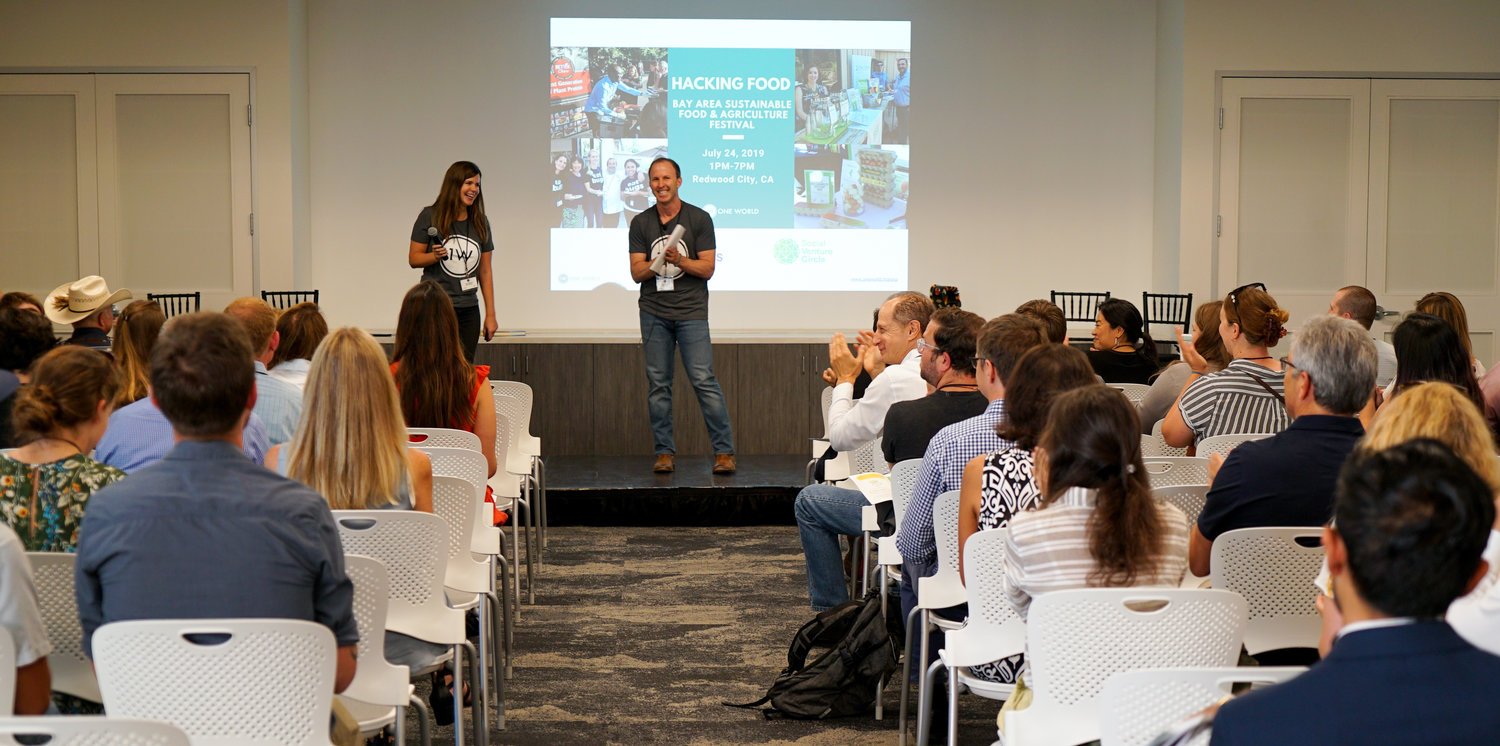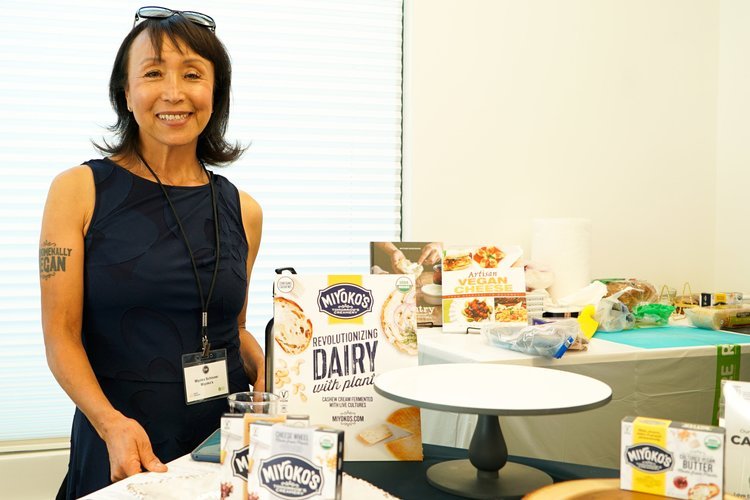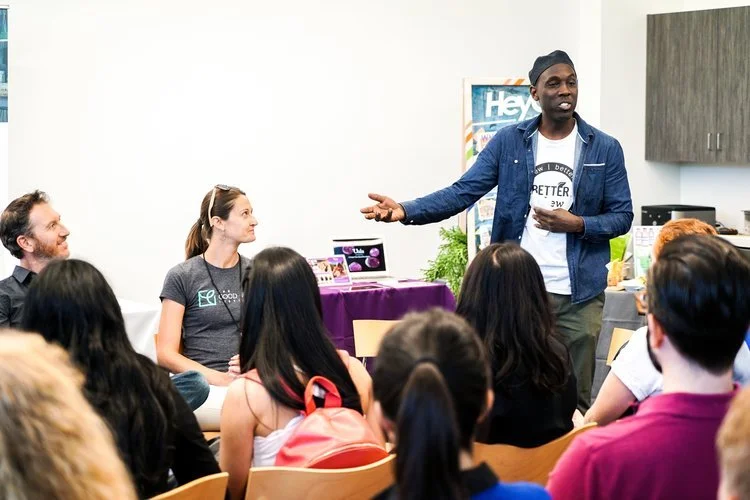Top Takeaways from Hacking Food 2019
ONE WORLD partnered with Spero Ventures to host the 4th annual Hacking Food Festival on July 24th in Redwood City. It was an inspiring day that brought together nearly 200 Bay Area investors, companies, entrepreneurs, and other professionals moving the needle on food sustainability in the food and agriculture ecosystem. Attendees heard from experts working in many facets of the food and agtech space, participated in interactive workshops, got their first look at the new ONE WORLD Sustainable Food & Agriculture Directory, sampled food and drinks from 25 local companies and connected with their innovative, mission-driven peers.
Liz Carlisle & Bob Quinn, co-authors of Grain by Grain and keynote speakers at Hacking Food 2019.
The conversations spanned from investment opportunities in food and agriculture to innovations in plant-based protein to the future of organic farming, with many topics in between. Here are six of our top takeaways from the numerous insights we gained at the event.
1. FARMERS ARE TURNING THE TIDE IN THE ORGANIC FOOD MOVEMENT.
Consumers are definitely creating more demand for organic products every year-- at a rate of 6-8% annually to be exact. But as Bob Quinn, a fourth-generation organic farmer and author of Grain by Grain explained, farmers are simultaneously leading the movement to convert their conventional farms to organic growing practices. As a farmer, Bob grows organic ancient wheat. He says that when he officially converted his farm to organic production in 1989, profits went up, cost of inputs went down and market share increased.
As an advocate, Bob speaks all over the country on organic agriculture’s benefits, and he also supports farmers to adopt organic growing methods. Through his conversations, other farmers are starting to understand the potential to capitalize on a business model that is not only more profitable, but better for the planet. He says that farmer interest in organic is higher than ever. “In the last few months I have had more inquiries from farmers on how to convert to organic than I’ve had in the last 30 years. The tide is truly turning.” If consumers continue to create rapidly growing demand and more farmers continue to meet it, Bob thinks the food system could easily grow from its current place of 6% organic food sales to nearly 100% in 30 years.
“I loved the CEO roundtable and curation of diverse set of strong impact focused, women-led startups - got the most value out of that. Thank you! Starting the main day with Liz and Bob about regenerative agriculture was also really good “level-setting” on a systems perspective for those in the room who are just coming into food systems.”
2. THERE ARE HUGE MARKET AND INVESTMENT OPPORTUNITIES IN ALTERNATIVE PROTEINS AND ALTERNATIVE DAIRY.
Hacking Food attendees sampled alternative proteins and vegan “dairy” products from companies like Miyokos, Spero Foods, Hooray Foods, Chirps Chips, Down to Cook and Something Better Foods. These companies showed us that as these food producers continue to evolve and innovate, plant-based alternatives are also tastier, healthier and more accessible than ever. In addition, research shows that about 49% of consumers are cutting down on meat and dairy intake for health and environmental reasons, making alternative proteins one of the hottest areas of food market growth.
Retail sales of plant-based meat alternatives had risen by almost 25% to an estimated $770 million in the twelve months up to August 2018. The broader US plant-based non-dairy milk market, which includes cheese, milk, creamer, butter, yogurt and ice cream, grew 50% in 2018 and currently represents about 15% of the entire dairy market. In addition, sales of non-dairy cheese increased by 43%, achieving $124 million retail sales, and non-dairy yogurt grew by 55% with retail sales reaching $162 million.
Chef Miyoko Schinner shared a variety of her amazing plant-based vegan “cheese” products.
3. THERE ARE BACKYARD SOLUTIONS TO CREATING FOOD EQUALITY AND ACCESSIBILITY.
Liz Carlisle, Stanford lecturer and co-author of Grain by Grain notes that the common question she hears around food is, “how do we make food cheap enough so that people can afford it”? But she says the question should be: “How do we install value in the entire food chain so that everyone benefits? How do we instead create a food system that is about cycling value to everyone in the food system?”
Liz notes that there are many aspects to our broken food system, but one of the largest is that many of the food insecure people in the US are the people that are creating our food (farmers, suppliers, fast food workers, etc.). “Many low income people are working the food system. We first have to think about how the food system impoverishes some people, and we need to move away from producing “cheap food” that keeps them poor.”
Liz says that while the organic food movement can sometimes be seen as elitist and not accessible to everyone, that there is a growing movement to build more local organic gardens in backyards, schools, and community spaces that is a much-needed solution for providing high-quality, local food. “We need more support to help people create gardens,” says Liz. “This is a supply chain that is reaching more people and not just high end markets.”
“As a new brand about to launch new concept/product the exposure from this event was extremely beneficial to help spread the word within the community like minded businesses and individuals. The response was overwhelmingly positive considering we did not have final packaged product and has helped me prepare for the launch of this brand.”
4. REGENERATIVE AGRICULTURE MOVES BEYOND ORGANIC, AND IT’S THE FUTURE OF SUSTAINABLE FOOD AND AGRICULTURE.
While the organic food movement continues to grow, another food movement has been gaining momentum as the new standard of agricultural health and sustainability: regenerative farming. Regenerative agricultural practices--like organic practices-- are chemical-free and do not harm the land or environment, but they also go a step further in that they also rebuild depleted soil and revitalize the entire farm environment.
Regenerative agriculture uses technologies that are fully holistic, incorporating permaculture and organic farming, and including practices like cover crops, crop rotation, conservation tillage, composting, mobile animal shelters and pasture cropping. These practices not only increase food production and topsoil, but ultimately increase farmers’ income as they use fewer inputs and welcome greater yields.
Chef Chew of Something Better Foods facilitates a panel on plant-based proteins with Dan Altschuler Malek of New Crop Capital and Liz Specht of the Good Food Institute.
5. AS GLOBAL POPULATION SOARS, THE DEMAND TO SUSTAINABLY SOLVE FOOD SYSTEM SCALABILITY WILL BE CRITICAL TO OUR FUTURE.
By 2050, The United Nations Population Division estimates a projected population of nearly 10 billion people on Earth. To feed that many people, means our current food system will have to increase food supply by 30% over the next thirty years. While the $7.8 trillion agrifood industry responsible for feeding the planet, it also employs over 40% of the population globally. It is also critical that companies consider limiting resources for efficient processes to simultaneously reduce the climate impact of food production. The companies that help solve these problems will create immense value for our communities, for the world and for their business organizations.
Currently in the US, 99% of the USDA research dollars go to chemical companies and conventional agricultural solutions. Organic, regenerative solutions get a mere 1%. As Bob Quinn noted in his opening panel, if research funding were allocated more equitably, it would provide a huge boost for sustainable, organic agricultural solutions and increase their overall potential impact on the food system.
6. INVESTMENT IN AGRIFOOD AND AGTECH MADE AN UNDENIABLE LEAP UP FROM 2017 AND IS A GROWING OPPORTUNITY FOR FOUNDERS AND FUNDERS.
From “Farm to Fork,” 2018 saw $16.9 B invested globally in agriculture and food tech startups, which is about an 11% increase from 2017. The shift towards a more sustainable food system means the opportunity is ripe for investors and agtech founders at the earliest stages of the supply chain, like planting, watering, growing, and harvesting as well as post-harvesting technology like farm robotics & equipment and innovation surrounding food safety monitors and traceability.
One of the least the least tapped into markets is sustainable packaging, which Clover CEO, Marcus Benedetti shared is a “thematic area for innovation.” Packaging is an integral element to food safety and preservation but accounts for nearly 9 million tons of plastic waste and by 2050, will lead to almost 200 million tons of food waste per year if the problem isn’t mitigated.
“It was wonderful to connect with other entrepreneurs to share journey, challenges and strengthen the support network for all those out there trying to make an impact! We also enjoyed connecting with the broader network of investors and companies actively working to help catalyze change.”
THANK YOU!
Thank you to all the entrepreneurs, companies, investors and participants that made the 2019 Hacking Food Festival our best one yet! We are especially grateful to our host Spero Ventures, our program partner Social Venture Circle and to The Town Kitchen for catering the event with wonderful local food. We look forward to seeing you at one of our upcoming 2019 events: Innovations in Corporate Social Impact on 10/30 or the Reel Impact Festival on 12/5!
Check out more photos from Hacking Food 2019:
(all images courtesy of Paula Saslow)

























